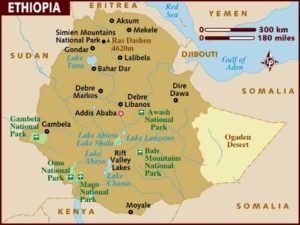
ABOUT ETHIOPIA
Ethiopia is a land of plenty with a long and noble history giving rise to ethnic, linguistic and cultural diversity. It is the only African country never to have been colonised. It has more than 80 unique rich ethnic, cultural and linguistic groups.
Ethiopia is renowned for its distinctive Christian tradition and association with the Ark of the Covenant. It offers the most dramatic scenery of unsurpassed grandeur (i.e. Simien Mountains National Park), unique rock-hewn churches, the spectacular Blue Nile Falls, the Great Rift Valley, the Danakil Depression, imperial castles, monuments of an ancient civilisation linked with the legend of the Queen of Sheba.
Calendar,
The Ethiopian calendar is much more similar to the Egyptian Coptic calendar having a year of 13 months, 365 days and 366 days in a leap year (every fourth year)
and it is much influenced by the Ethiopian Orthodox Tewahedo Church, which follows its ancient calendar rules and beliefs. The Ethiopian calendar is always seven years and eight months behind the Gregorian (Western) and Eastern Orthodox Church calendars during September and December and eight years and four months behind during January and August. Therefore, the Ethiopians will celebrate the new millennium on September 1, 2000 Ethiopian calendar (September 12, 2007 Gregorian calendar).
Culture,
Ethiopia is truly a Land of discovery – brilliant and beautiful, secretive, mysterious and extraordinary. Above all things, it is a country of great antiquity, with a culture and traditions dating back more than 3,000 years. The traveler in Ethiopia makes a journey through time, transported by beautiful monuments and the ruins of edifices built long centuries ago.
Ethiopia, like many other African countries, is a multi-ethnic state. Many distinctions have been blurred by intermarriage over the years but many also remain. The differences may be observed in the number of languages spoken – an astonishing 83, falling into four main language groups: Semitic, Cushitic, Omotic and Nilo-Saharan. There are 200 different dialects.
The Semitic languages of Ethiopia are related to both Hebrew and Arabic, and derive from Ge’ez, the ecclesiastical language.
Landscape,
Location and Geography. Ethiopia is the tenth largest country in Africa, covering 439,580 square miles (1,138,512 square kilometers) and is the major constituent of the landmass known as the Horn of Africa. It is bordered on the north and northeast by Eritrea, on the east by Djibouti and Somalia, on the south by Kenya, and on the west and southwest by Sudan.
The central plateau, known as the highlands, is surrounded on three sides by desert with a significantly lower elevation. The plateau is between six thousand and ten thousand feet above sea level, with the highest peak being Ras Deshan, the fourth-tallest mountain in Africa. Addis Ababa is the third-highest capital city in the world.
The Great Rift Valley (known for discoveries of early hominids such as Lucy, whose bones reside in the Ethiopian National Museum) bisects the central plateau. The valley extends southwest through the country and includes the Danakil Depression, a desert containing the lowest dry point on the earth. In the highlands is Lake Tana, the source of the Blue Nile, which supplies the great majority of water to the Nile River Valley in Egypt.
Variation in altitude results in dramatic climatic variation. Some peaks in the Simyen Mountains receive periodic snowfall, while the average temperature of the Danakil is 120 degrees Fahrenheit in the day time. The high central plateau is mild, with a mean average temperature of 62 degrees Fahrenheit.
The bulk of the rain in the highlands falls in the major rainy season from mid-June to mid-September, with an average of forty inches of rain during that season. A minor rainy season occurs from February to April. The northeastern provinces of Tigre and Welo are prone to drought, which tends to occur about once every ten years. The remainder of the year is generally dry with comfortable .
